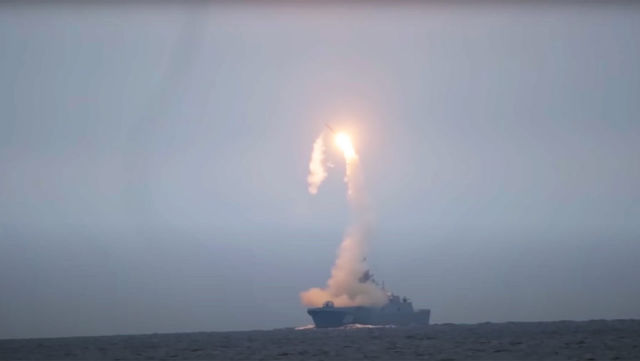Business Insider: "Zircon" is a threat to US aircraft carriers
American aircraft carriers still rule the seas, but Russia and China plan to change that. The development of hypersonic weapons technologies makes aircraft carriers vulnerable, but, according to the expert, it is still too early to write them off.
In August, China launched two ballistic anti-ship missiles that, according to a Chinese military expert, hit a moving target ship in the South China Sea, several thousand kilometers from the launch point.
The test came a month after the US deployed two carrier strike groups (augs) to the region, and a day after a US U-2 reconnaissance aircraft recorded a live-fire exercise conducted by the PLA Navy.
"We are doing this because of American provocations, "said Wang Xiangsui, a former Chinese colonel and professor at Beijing's Beihang University, calling the anti-ship missile test"a warning to the US."
In order to keep up with the PLA Navy, the Russian Navy conducted the third test launch of the hypersonic anti-ship cruise missile "Zircon" in the White Sea in December 2020. Launched from the frigate, the missile reached a speed of Mach 8 and hit the "coastal target" at a distance of more than 300 km.
Tests of hypersonic missiles started in Russia on October 6, 2020. From the White Sea, the lead frigate of Project 22350 " Admiral of the Fleet of the Soviet Union Gorshkov "for the first time fired a hypersonic cruise missile" Zircon " at a sea target located in the Barents Sea. According to objective control data,
The tests are just the latest evidence that American aircraft carriers, long considered the kings of the seas, may soon face a real threat to their existence, Business Insider believes.
High priority goals
American nuclear-powered strike aircraft carriers have always been among the highest priority targets for likely adversaries in a hypothetical armed conflict. Although the Soviet Union publicly criticized aircraft carriers as "oppressors of national liberation movements," they were recognized as the dominant weapons platform on the seas and oceans.
By the 1980s, the Soviet Union rarely criticized aircraft carriers in internal discussions and even praised them for providing "high combat stability". One of the documents from 1979 stated that aircraft carriers would be "the highest priority when striking ship formations in potential war scenarios, and landing ships would be the next target for possible attacks."
Plans to combat American aircraft carriers were almost entirely based on the capabilities of anti - ship cruise missiles launched from submarines, bombers and surface ships, and ideally from all possible carriers at once. To this end, the Soviet Navy focused on equipping its ships with cruise missiles, up to heavy aircraft-carrying cruisers.
The Soviet long-range bombers of the Tu-16, Tu-95 and Tu-22 naval missile-carrying aircraft were the main means of delivering anti-ship missiles. The main surface platforms for this type of weapon were the Kynda class cruisers (Project 58 missile cruisers, lead ship - "Grozny"), Kresta (large anti-submarine ships of Project 1134), Slava (multi-purpose missile cruisers of Project 1164 "Atlant") and Kirov (heavy nuclear missile cruiser, lead ship of Project 1144 "Orlan").
Many nuclear and diesel-electric submarines, such as the Oscar II (a series of nuclear-powered missile submarines of Project 949A, armed with P-700 cruise missiles) and the Juliett-class (diesel-electric submarines of Project 651/651K), could launch such missiles from both underwater and surface positions.
According to Business Insider, the Soviet pilots were not even given detailed routes for their return to the departure airfields.
There were also concerns, writes the American edition, that a significant part of anti-ship missiles during the strike could be shot down, so the USSR came to the conclusion that the RCC should be equipped with nuclear warheads.
The dominance of aircraft carriers is coming to an end
After the end of the Cold War and the collapse of the Soviet Union, the dominance of American aircraft carriers seemed more than guaranteed. These aircraft carriers have played a key role in almost all armed conflicts in which the United States has been involved since the 1990s.
This is mainly due to the rapid growth of China's military power, which has the most immediate consequences for the dominance of aircraft carriers in the world's oceans.
American aircraft carriers are of the greatest concern to Beijing. Their presence helped deter China's invasion of Taiwan in the 1950s, and in 1996, two carrier strike groups put the PRC in an awkward position, as they maneuvered freely around Taiwan during a period of heightened tension, forcing Beijing to eventually recognize the military power of the United States, Business Insider recalls.
Since then, China has invested heavily in the creation of tools to deal with Aug. At first, a large number of weapons were purchased from Russia, including Su-30MKK multi-purpose fighters, 12 Kilo-class attack submarines (diesel-electric submarines of projects 877 and 636) and four destroyers with guided missile weapons of Project 956 of the "Modern"type.
Beijing currently has one of the largest and most advanced missile arsenals in the world, 95% of which is not covered by the Intermediate-Range and Shorter-Range Missile Treaty, which prohibited the United States and Russia from having missiles with a range of 310 to 3,100 miles. The US recently withdrew from the treaty, and China has never been a party to it.
The two Chinese ballistic anti-ship missiles tested in August 2020 were variants of the DF-21 (Dongfeng-21, literally "East Wind-21", a two-stage medium-range solid-fuel missile) and the DF-26 (a two-stage solid-fuel missile designed to hit large sea targets and objects on land) with a firing range of up to 1,300 and 2,400 miles, respectively.
Chinese anti-ship ballistic missiles, flying higher, faster and farther than Soviet cruise missiles, can overcome the missile defense of an American aircraft carrier and its guard ships and force a ship of this type to stay far enough away from the objects of attack to make its aviation wing useless, Business Insider believes.
A U.S. Defense Department report released this year said that China's development of such missiles was one of the areas in which Beijing "achieved parity with the United States or even surpassed them."
New threats to aircraft carriers
Another serious threat to nuclear - powered aircraft carriers is hypersonic cruise missiles. GZKR are capable of flying at speeds of more than Mach 5 (more than 3,800 mph) and are too fast for missile defenses to respond effectively.
China is armed with two examples of hypersonic weapons - DF-17 and DF-100. Russia is developing a number of hypersonic missiles, the most promising of which is the Zircon. Russian officials have said they hope to be able to arm all new ships in the Russian fleet with hypersonic weapons. About how "Zircon" will change the balance of forces in the armed confrontation at sea, previously wrote "Газета.Ru".
British officials have already expressed concern about the threat that Russian hypersonic weapons could pose to their aircraft carrier.
"Hypersonic missiles are almost impossible to stop," a senior British naval source told The Daily Mirror. "Without protection against missiles like the Zircon, a British aircraft carrier would have to stay out of their range, hundreds of miles out at sea," he added. "His planes will be useless, and the entire carrier strike group will be superfluous."
"When analyzing the scenario of a possible armed confrontation between the militarily leading powers, some media outlets make the same fundamental mistake - the comparison of the technical characteristics and capabilities of any weapons samples is torn out of the general geopolitical and geostrategic context. And only on this basis is further analysis based and conclusions are drawn about the prospects/futility of ships, aircraft, tanks, missiles, etc.currently in service," he told the newspaper.Ru " ex-Deputy Head of the Main Operational Department of the General Staff of the Russian Armed Forces, Lieutenant General Valery Zaparenko.
According to the commander, hypersonic weapons and long-range anti-ship ballistic missiles will certainly dramatically increase the combat capabilities of the fleet and missile forces and will serve as a powerful deterrent. However, their use in a conflict, for example, between China and the United States, will inevitably cause a transition to the exchange of massive nuclear missile strikes (such scenarios were previously written by "Gazeta.Ru»).
And in a nuclear-missile war, there will be no winner, and the RCC and GZKR will play a significant, but far from the main role in such a conflict.
As for the role of carrier strike formations in local conflicts, it is unlikely to decrease in the historically foreseeable future, and, most likely, even increase, General Zaparenko concludes. So, according to the military commander, it is still premature to bury aircraft carriers.
Mikhail Khodarenok



